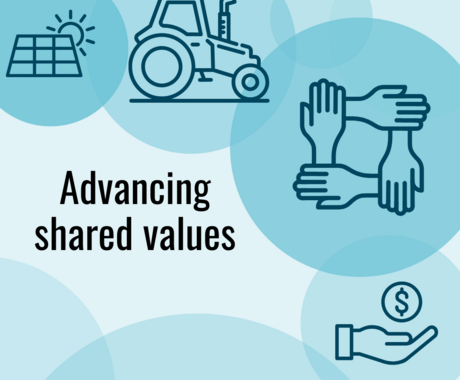Combining row crops and solar energy has been relatively uncommon, but in Olivia, Minnesota, forward-thinking farmers, John Baumgartner and Rolly and Larry Rauenhorst, are demonstrating how solar power generation can be integrated into a corn-soybean operation, creating what they refer to as a "double-cropping" system.
Agrivoltaics, also known as dual-use solar or agrisolar, is the practice of using the same land for both solar energy and agriculture production. The practice can include growing crops, raising livestock, or creating pollinator habitats beneath solar panels.
After nearly five years of planning and building, the Rauenhorst Farm Agrivoltaics Project is up and running. Funded by an award from the University of Minnesota (UMN) Extension’s Southwest Regional Sustainable Development Partnerships, the project will allow UMN researchers to monitor soil and climate conditions as well the performance of a corn and soybean crop below the panels.
The one-of-a-kind solar project is a 36 kilowatt system comprising 10 individual sets of panels that tower 14 feet above a corn and soybean rotation field. The height of the panels allows the farmers to maintain use of conventional equipment below. The custom racking holding the panels was engineered using recycled oil field pipes as posts to accommodate the cropping system and equipment. Dual-axis arrays track the sun as it moves from east to west each day, shading only 7.5% of the ground. The panels also have the ability to level out horizontally if sensors indicate that wind speeds have become too high.
“We are looking at the interconnection between the field and the grid, distributing our options over the entire bread basket,” said Rolly Rauenhorst.
At a recent field day planned by the organization Clean Energy Resource Teams, those in attendance met with the Rauenhorsts and others who made the project possible. Additionally, attendees trekked into the cornfield to see the project up close.
Minnesota is a leading state for agrivoltaics. According to the Innovative Solar Practices Integrated with Rural Economies and Ecosystems project, 584 agrivoltaics sites are in the U.S., with 258 located in Minnesota.
Most of the sites in Minnesota are managed as habitat, such as pollinator support or native grasses, or by incorporating animal grazing into the management of site vegetation. Before the Rauenhorsts launched their project, only two of the Minnesota sites include crop production activities, both specifically growing various types of vegetables. There is an opportunity to combine solar with traditional row crops, like corn and soybeans, but there is a lack of research on using this method of farming.
UMN researchers will document the performance of the solar energy and crop production at the Rauenhorst site as they rotate between corn and soybeans over the next several growing seasons. A range of variables will be measured, including solar radiation levels, temperature, wind speed, and the effect of different levels of shade from the panels on corn and soybean growth. Through the current field research, researchers seek to understand how solar panels in the field affect corn and soybeans from planting to harvest.
Overall, the Rauenhursts hope to show that there can be a balance between producing energy with little to no crop loss in a traditional row crop operation. Agrivoltaics provides an exceptional opportunity to support both Minnesota’s agricultural industry and its clean energy transition efforts.
Feature photo: On the Rauenhorst Farm, the solar arrays stand 14 feet above a corn field. | Photo by Cora Hoffer





